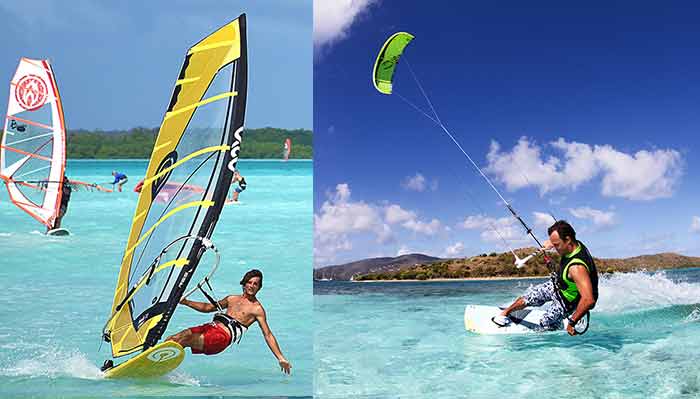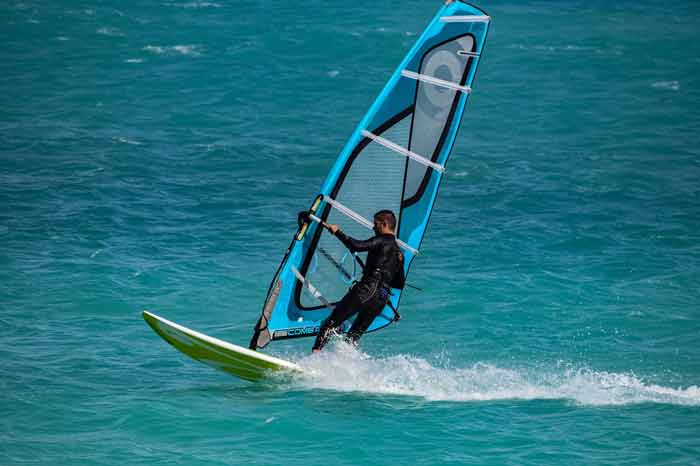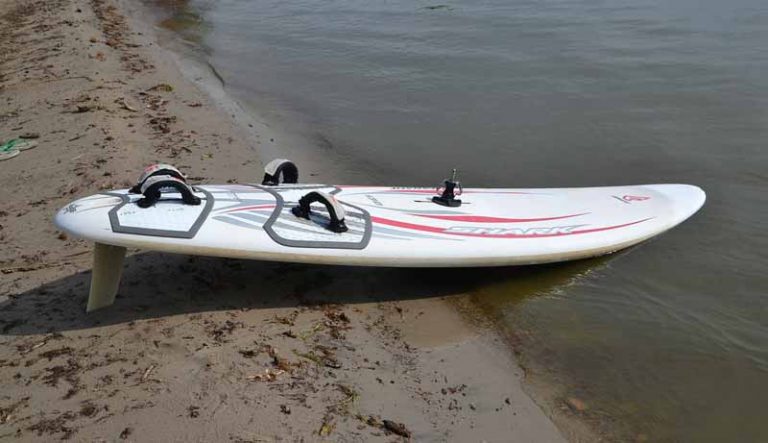How to Windsurf: Beginner Guide + Tips & Techniques
Be it you’re a beginner or a veteran windsurfer, room for improvement is always huge. Truth is, learning never ends. In here , learn all you need from the equipment, steps, techniques, safety precautions and tips to up your game.
How to Windsurf: Steps
What you will need
Windsurfing cannot be complete with the following equipment
The surfing board which is an elongated surface that provides a surface to stand on when sailing.
Rig. This consists of a sail, mast and a boom. The boom provides a place to hold onto while you are sailing whereas the mast is used for support purposes.
Protective wear which include wetsuit, rescue coat, helmet, shoes and sunglasses.
Steps/Instructions
Generally, being a game of balance, you need to know how to balance the board and your weight before you begin surfing. Here are some basic steps that you can follow to arrive at better and exciting surfing.
Preparation
You are required to put on a wetsuit, shoes, rescue coat and helmet. Ensure you carry a whistle with you for use in case you need any help while in the waters.
Remember to carry a floatation gadget close to you. Finally ensure the board; rig, boat and any other equipment to be carried are in good conditions.
Step 1:
Push the boat into deep water such that the fin is clear of the bottom. Getting the sense of the wind direction, make a quick decision of how you would like to move.
Make sure the sail is at downwind of the board making a T position. Therefore, the board should be set at a right angle to the wind.
Step 2:
Swim or walk to the upwind side and stand up onto the board. Staying on your knees, hold the up haul without pulling up the sail. Thereafter, raise your feet at a slow pace, making sure you are very stable.
Step 3:
Pull the sail by standing up straight to avoid hurting your back. You are also encouraged to turn your shoulders and move up the up-haul with hands until the mast is in reach with the next shoulder turn.
Ensure that you pull the sail until the point where it is just touching the water. This means that as long as the sail is in contact with water, you should keep pulling it.
Step 4:
Take hold of the mast and let it swing in a control position. Ensure that the sail at this point comes back to you and does not go away from you.
When the mast is in the front hand, your feet are supposed to move towards the back of the board. This prevents you from leaning backwards as well as falling in the water.
When behind the mast, make sure that you grab the boom with the backhand. Now close the sail softly.
Step 5:
Start steering in the above position. Tilt the mast left and let your body transfer these imbalances to the board which will make it turn clockwise. The vice versa is true.
Remember, during times of strong winds and further tilting, the board turns faster as compared to conditions of light wind. [1]Additionally, a tilt of the mast to the front side bears off the board from the wind.
Step 6:
Observe the side of the bow that is in relation to you, and then place your lower hand on the boom for the mast to lead the sail to the front as you start moving. You are urged to ensure that the sail does not pull you down. Let the mast be perpendicular to the board by leaning back and keeping your hands straight.
Using the back hand, pull the mast to accelerate. If you need to slow down, let it out. Here, you are required to ensure that your feet remain behind the mast foot with the toes of the front foot facing forward.
In case you need to stop, relax and return to the safety position. You can also stop by dropping the boom and make sure it goes ahead of you. However, the latter is tiresome as you have to keep on picking it up.
Safety/Dangers
Although windsurfing is a great exciting sport that is fun with ease of starting, it has its faults too. These are as discussed below;
Injuries
Common injuries that you may experience while windsurfing include skin damage, direct impact injuries such as blows to the head and body, back injuries, sprains, fractures and sometimes dislocation of the shoulders.[2]
Hypothermia
This refers to a condition in which the body loses heat at a faster rate than it can produce leading to low body temperatures.
Drowning
Occasionally, you may drown especially if you don’t know how to swim. You are therefore urged to make sure you have safety materials with you. Sailing as a group will also help you when need arises.
Drowning may be as a result of very strong winds acting on your mast therefore increasing your boards speed. It may also result from sudden strong waves in the sea or ocean.
Safety Measures
Some of the safety measures you can undertake to prevent dangers during windsurfing are as outlined below:
- Inspect your kit. Ensure your board; mast and boom are in good condition. Make sure that the mast rubber is in a good position (has not stretched beyond its elastic limit).
- Avoid windsurfing in the storm. This will help prevent wipeout of your sail therefore curbing any injury that may occur.
- Practice forecast to ensure the weather is conducive and will be favorable for sailing in the shores.
- Ensure you wear a helmet to prevent head injuries in case an accident occurs during this time. Safety gears are also highly recommended to reduce the consequences.
- Before going in water, make sure that there is at least someone to keep watch over you. Don’t try it alone.
- Understand the rules before trying to prevent back injuries. You should always try to be in the appropriate position.
Tips to be a better windsurfer
Windsurfing is one of the greatest ways to socialize, have fun and make good use of your free time. Therefore, you are highly encouraged to try becoming a better sailor each day. Here are some tips that can help you achieve being a better windsurfer.
Preparation
Generally, in all the activities you plan to undertake, the state of both mind and body serves a great purpose and determines whether you can achieve your goals or not. In the same way, mental and physical preparation plays a big role in improving your skills in flat water sports.
You are therefore encouraged to make sure that both your body and mind are in perfect shape before undertaking any step. This can be achieved by undertaking activities such as squats and other aerobics tricks.
On the other hand, watching videos of persons windsurfing can help bring your mind in a good state ready to learn new tricks as observed. This will also help program your muscle making them ready to undertake the process.
Practice
According to Sam Ross, a great instructor and a team 15 coach, becoming a better skilled windsurfer requires a lot of practice. He adds that often practice will enable you advance your skills in both strong bigger winds and when the winds are cool.
You are highly encouraged to always practice in all situations but not only when the conditions favor your already acquired skills. Handling your windsurfing equipment in all times will enable you achieve better skills hence become a better windsurfer.[3]
In addition, the more you make mistakes during the practice, the better. This is simply because on correcting the faults made over and over, you will be able to learn more hence progressing in your activities.
Trying out new tricks is a perfect way to advance your skills in windsurfing. Change the tricks when you are sailing and try something different for your skills to get better.
Take extra lessons
A windsurfing school with good reputation and updated equipment will be a perfect place to go for extra lessons. You are advised to first search for any information regarding the school you need to study in from colleagues. This can be done by reading testimonials given by persons who have gone for lessons in such an institution.
In case of many positive feedbacks then that gives you a perfect chance to know that your school of choice is the best to do your studies.
Avoid Distractions
It always fun to take leisure activities with family and friends. Despite this, you are encouraged to avoid their company at any cost especially when you need time to focus and become a better windsurfer.
In most cases, these are persons in the same category as you are hence having the same like minds. Meaning that you may end up not learning much. It is a different case if that family member or friend is a pro at windsurfing.
You may bring you family or friend when your instructor is away or may be after your classes.

Understand that it’s easy to windsurf
This is the first thing you are required to put in mind as you achieve what the mind conceives. Windsurfing is not as difficult as you might think. However, it takes a lot of patience, practice and much time in water.
Additionally, the windsurfing equipment makes learning easier and exciting due to its excellent design. The boards are quite stable with short shape which enables you balance easily and take great control of the forward moves.
To add on this, the windsurfing kit contains decks with firm grips. This is so as to offer the required grip to maintain the balance as well as to prevent your shins from injuries while trying to enter the board.
A big number of people may not give a try to windsurfing as they think it’s a difficult task to undertake due to the weight of the kit. Although, this is actually not the case as the sails, masts and the booms have been advanced in their design makes production of lighter kits.
Make use of the right windsurfing kit
You are advised to use the right type of equipment. This depends on factors such as your weight, where to windsurf as well as your age; for the case of the kids. Further, choosing the right instructor will give you a great chance of learning faster.
Moreover, a well-chosen area or region to try windsurfing gives you an easy moment to learn how to become an expert in this sector. For instance, the Cape Sports Center has up to date boards and sails of a fresh learner which are specifically made for the beginners.
Further, giving a try using your friend’s kit may pose a great challenge to you. The reason being that it might have a very long board or the sail being too heavy for you to control hence making it difficult for you to learn.
Obtain an instructor or trainer
One of the best ways to learn on how to windsurf is by getting a trainer to teach you some lessons which will help a beginner give a try to windsurf. You are therefore advised to seek some lessons with a professional instructor.
Basically, you cannot just give it a go since it involves many activities going on at once which include controlling the sail, balancing on the board and noting the wind’s speed and direction among other activities. Therefore, you really require the lessons so as to at least understand what exactly you going to do on the waters.
A couple of lessons before experimenting make your sailing faster to understand as well as more exciting. Hence, it is required that you undergo some training before commence of sailing activities.
Choosing the right sailing place
For you to begin or learn on how to windsurf, you need to know where to sail from. This incorporates places with masses of water such as seas, lakes, oceans or even the rivers.
Although, there are many regions with flat waters, the choice of where to windsurf matters on whether easy or difficult to learn. You should therefore consider factors such as the consistency of winds alongside level of the flat water.
Experience from experts show that Lange Baan, a place where the Cape Sports Center is located has a sheltered lagoon with steady and reliable winds making it a perfect place for the beginners to learn how to ride.
Alongside the reliable winds, the lagoon offers a couple of aspects such as flat water and waves which facilitates the learning of greater ways of windsurfing together with a couple of new tricks.
Use your own time for perfection
Being a tiring sport activity, it is required that you take your time to learn. Sometimes, it is necessary that you take breaks when tired so as to rest.
Due to the above reason, it becomes difficult to learn this within a day or two, therefore it is required that you take your own time and try riding by your own. Progression in sailing requires hard work with lots of patience and much use of your time for practice.
Set achievable goals
Sometimes, it is normally good for you to set some goals that act as guidelines if at all you need to make a positive progress in your work. This enables you to perfectly push your efforts to achieve them which eventually make you advance to the next level making you a better sailor. Goals will always make you aim higher and achieve better results.
Changing the size of your board
Generally, a bigger board together with a smaller kit if you sail in a region with light winds is usually encouraged to be put in use. A high-volume kit secures you when left hanging in the sea since it brings you back to the beach.
However, this is not recommended during winter due to the change in temperatures. Moreover, large volume boards will make you lose control hence become unable to turn as required. If the winds become strong, you are encouraged to use a smaller board.
Learning to sail in both small and bigger boards in all conditions will make your skills better eventually becoming a better windsurfer.
[1] https://www.wikihow.com/Learn-Basic-Windsurfing
[2] https://www.betterhealth.vic.gov.au/health/healthyliving/windsurfing-preventing-injury
[3] https://boards.co.uk/features/top-3-tips-to-becoming-an-advanced-windsurfer/





